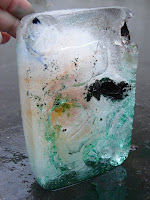
Monday, 24 November 2008
Sunday, 23 November 2008
The glacier as a metaphor for a transforming and moving landscape describing the relationship between external and internal forces.
The Transformtation/allocations of moving land-scapes - creating new
The ground: allowing the masses of ice to form and shape the landscape of the surround
The inner world of the glacier: a space of protection but transformation/archiving and rearranging information
The settlement: The connection to the circels of humans
What are those places are being used for? How is the term glacier reflected on a language level
The Transformtation/allocations of moving land-scapes - creating new
The ground: allowing the masses of ice to form and shape the landscape of the surround
The inner world of the glacier: a space of protection but transformation/archiving and rearranging information
The settlement: The connection to the circels of humans
What are those places are being used for? How is the term glacier reflected on a language level
Thursday, 20 November 2008
Wednesday, 19 November 2008
Sunday, 16 November 2008
Tuesday, 11 November 2008
Monday, 10 November 2008
Tuesday, 4 November 2008
Sunday, 2 November 2008
„Besides , consciousness is subject to a certain restriction. At any given instant it can only fix on a smaller number of objects simultaneously. Everything else is, at that moment, unconscious, it is only the sequences and successions of these conscious “snapshots” that give us the impression that our conscious world forms a continuum, that we are perceiving and comprehending our world within an overriding context. We can never form a picture of the world in its entirety, our consciousness is too limited for that, we can only see what the spotlight happens to illuminate”. (C.G.Jung, “The Tavistock lectures 1935”).
Unlike space and residence the path is everflowing. Its essence is movement, restlessness, flux. It has a utopian side. ”The path is the mark of infinitive distance. It sets the static landscape in motion towards the horizon” (Linschoten).The flowing character of the path reinforces our sense of the flow of time.” When we stand, we stand in Heraclites River. When we walk, we ourselves become a river, a drop in this river, a piece3 of wood floating upon it. It is probably fear that always starts us moving again, fear of being washed away, of being submerged. Standing, time roils past our bodies like floodwaters around the piers of a bridge. Moving the passage of time becomes endurable”(Rosei).
Subscribe to:
Comments (Atom)









































